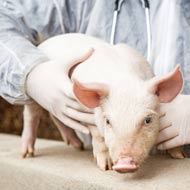
EMA advice could see colistin sales fall by 65 per cent
EU member states have been advised to minimise their use of colistin in animals, to reduce the risk of antimicrobial resistance.
The European Medicines Agency (EMA) said medicines containing colistin should only be used as a second line treatment for animals.
The move follows the recent discovery of a gene (MCR-1) that allows bacteria to become resistant to colistin - a 'last resort' antibiotic used in human medicine to treat infections caused by multi drug resistant bacteria.
As the gene can be transferred between different types of bacteria, the finding prompted fears of a pan-resistant bacteria.
Since being initially identified in China last year, MCR-1 has been found in the EU and is thought to be 'circulating' in the US.
In the next three to four years, the EMA says all European Union member states should cut the use of colistin in animals to 5mg colistin/population correction unit (PCU) - the estimated weight of livestock and slaughtered animals. The recommendation could see a 65 per cent reduction in sales of colistin for veterinary use, across the EU.
Member states are, however, encouraged to set even stricter targets - ideally below 1mg/PCU.
The Antimicrobial Advice Ad Hoc Expert Group (AMEG), which was asked to reevaluate colistin use, makes it clear that other antimicrobials should not be used to compensate for the reduction in sales of colistin. Instead, other measures should be sought, such as improved farming conditions, biosecurity and livestock vaccination.
AMEG also recommends that colistin be reclassified as a category 2 medicine, reserved for treating infections in animals when there is no other alternative. The list contains classes of antimicrobials that are critical to human health.



 The BSAVA has opened submissions for the BSAVA Clinical Research Abstracts 2026.
The BSAVA has opened submissions for the BSAVA Clinical Research Abstracts 2026.